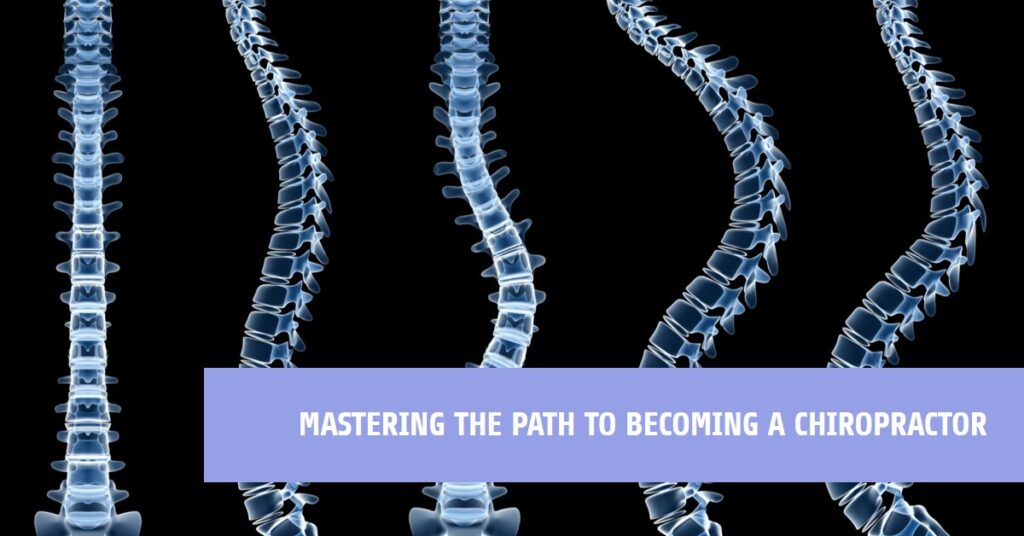Becoming a Chiropractor, the pivotal role of chiropractors cannot be overstated. These professionals specialize in addressing a myriad of issues related to nerves and muscles through non-invasive methods, providing gentle yet effective treatments. This comprehensive guide is meticulously crafted to illuminate the intricate journey of becoming a chiropractor, offering invaluable insights and actionable steps towards a fulfilling career in this esteemed profession.
Understanding the Distinctive Role of Chiropractors
Chiropractors are adept at alleviating a spectrum of musculoskeletal ailments, including chronic back pain, joint discomfort, and sciatica, without resorting to invasive procedures or pharmaceutical interventions. Instead, they employ a holistic approach, utilizing gentle techniques such as hands-on adjustments to realign muscles and bones, thereby enhancing overall well-being and mitigating pain.

Exploring the Duties and Responsibilities
The responsibilities shoulder by chiropractors are multifaceted and encompass a wide array of crucial tasks essential for patient care and treatment. These include:
- Medical History Assessment: Conducting thorough evaluations of patients’ medical backgrounds to devise personalized treatment plans.
- Posture and Alignment Analysis: Assessing posture and spinal alignment to pinpoint areas of concern.
- Spinal and Joint Manipulation: Skillfully performing adjustments to realign the spine and other joints as necessary.
- Pain Management Planning: Crafting tailored plans for pain management tailored to individual needs.
- Non-Invasive Treatment: Employing diverse modalities such as massage, heat/cold therapy, and targeted exercises for pain relief.
- Holistic Health Guidance: Offering nutritional advice and lifestyle recommendations to augment overall well-being.
- Diagnostic Interpretation: Proficiently interpreting diagnostic tests such as X-rays to inform treatment decisions.
Embarking on Your Journey: The Path to Becoming a Chiropractor
Becoming a chiropractor necessitates traversing a well-defined path characterized by rigorous education, comprehensive training, and licensure. Here’s a meticulous breakdown of the essential steps:
1. Undergraduate Preparation for Becoming a Chiropractor
Commence your odyssey by completing a bachelor’s degree or fulfilling prerequisite course requirements, typically comprising approximately 90 credit hours. Various chiropractic schools may impose distinct admission criteria, necessitating thorough research into each institution’s prerequisites. Optimal undergraduate majors include disciplines closely intertwined with chiropractic care, such as exercise science, human biology, or health sciences.
2. Doctor of Chiropractic (DC) Degree
Upon satisfying undergraduate requirements, proceed to enroll in a Doctor of Chiropractic (DC) degree program. These rigorous four-year programs encompass a blend of theoretical coursework and hands-on training. Throughout your academic tenure, you’ll delve into subjects such as anatomy, radiology, kinesiology, and fundamental chiropractic principles. Culminating your academic journey entails undertaking rigorous examinations administered by the National Board of Chiropractic Examiners (NBCE).
NBCE Examination Breakdown:
- Part I: Encompasses foundational sciences, including spinal anatomy and microbiology.
- Part II: Expands into clinical sciences, incorporating diagnostic imaging and advanced chiropractic principles.
- Part III: Focuses on clinical proficiency, evaluating chiropractic techniques and case management.
- Part IV: Assesses hands-on skills through practical examinations in chiropractic technique and case management.
3. Obtaining Licensure
Following successful completion of NBCE examinations and graduation from chiropractic school, securing licensure from your respective state is imperative. Each state delineates its unique licensure prerequisites, typically encompassing background checks, malpractice insurance, and state-administered assessments. Furthermore, maintaining licensure mandates ongoing education, entailing regular participation in classes or courses to remain abreast of advancements in the field.
4. Considering Specialization
Augment your proficiency by pursuing specialized certifications aligned with your career aspirations. These certifications span diverse domains such as pediatric chiropractic care, sports rehabilitation, acupuncture, and clinical nutrition. Acquiring certifications not only broadens your skill set but also enhances your prospects for a flourishing career.
5. Cultivating Work Experience
Initiate your professional voyage by accruing hands-on experience congruent with your career trajectory. Explore diverse employment opportunities, including private practice ownership, associate positions within established clinics, or freelance contracting. Each pathway offers unique advantages, necessitating careful deliberation aligned with personal predilections and long-term objectives.
Navigating the Landscape of a Chiropractor’s Career
Chiropractors play a pivotal role in enhancing the well-being of millions of individuals across the United States annually. Their duties encompass a myriad of tasks tailored to meet patients’ needs, circumstances, and requisite levels of care. Typical responsibilities include:
- Assessing a patient’s medical condition.
- Conducting thorough physical examinations.
- Analyzing patients’ posture, spine, and reflexes.
- Performing diagnostic tests and interpreting X-rays.
- Administering neuromusculoskeletal therapy, including spinal adjustments.
- Providing guidance on health and lifestyle factors, such as exercise and nutrition.
- Referring patients to other healthcare professionals as necessary.

Essential Skills for Exemplary Chiropractic Practice
To excel as a chiropractor, cultivating a diverse array of skills is paramount, encompassing both interpersonal aptitude and technical prowess:
- Effective Communication: Facilitating meaningful interactions with patients and articulating treatment plans with clarity and empathy.
- Manual Dexterity: Demonstrating precision in executing adjustments and manipulations with finesse.
- Problem-Solving Acumen: Navigating complex clinical scenarios adeptly and devising innovative solutions to address patient needs.
- Empathy and Compassion: Fostering a supportive therapeutic environment and prioritizing patient well-being.
- Technical Proficiency: Mastering diagnostic techniques, interpretation of diagnostic imaging, and therapeutic modalities integral to chiropractic practice.
Recommended Chiropractic Courses
- Neuroscience
- Chiropractic Philosophy & History
- Spinal Radiology
- Principles of Physiopathology
- Emergency Procedures
- Musculoskeletal Physiopathology
- Bone and Joint Imaging
- Soft-Tissue Technique
Exploring Job Opportunities and Compensation
According to the US Bureau of Labor Statistics (BLS), chiropractors in the United States command a median annual salary of $75,000 as of May 2021. Earnings are influenced by diverse factors including geographic location, specialized certifications, and practice setting. Career progression pathways encompass diverse trajectories ranging from practice ownership to roles in education, research, or administration, offering avenues for professional advancement and specialization.
Embracing Flexibility in Workspace
In recent years, the trend of remote work has gained traction across various industries, offering newfound flexibility and autonomy. Even chiropractors, albeit requiring less technological infrastructure, can capitalize on this trend by establishing home offices. Working from home not only saves time and expenses associated with commuting but also affords chiropractors the opportunity to optimize their work environment and potentially qualify for tax benefits.
Pioneering Your Own Practice
Embarking on the journey of entrepreneurship beckons as a compelling option for chiropractors, affording unparalleled autonomy and freedom. Approximately 30% of chiropractors opt for self-employment, enabling them to dictate their schedules, choose their work locales, and exercise full control over their practices. This autonomy fosters a sense of ownership and enables chiropractors to tailor their practice to align with their professional aspirations and personal values.
Launching Your Career in a Clinic Setting
Starting your career in a clinic setting offers invaluable practical experience for chiropractors fresh out of college. Here’s why:
- Hands-on Experience: Clinics provide opportunities to work directly with patients, honing diagnostic and treatment skills.
- Guidance from Professionals: Working under experienced chiropractors allows for mentorship and guidance, facilitating skill development and confidence.
- Real-world Application: Clinics offer a real-world environment to apply theoretical knowledge gained in chiropractic college, bridging the gap between academia and practice.
Starting your journey towards becoming a chiropractor is an exciting endeavor filled with opportunities for growth and impact. By following the steps outlined in this guide, you can embark on a fulfilling career dedicated to improving patient health and well-being.